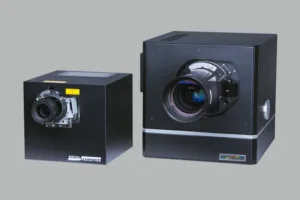Digital Projection will use its impressive booth (#1642) at this year’s InfoComm (June 12-14 in Orlando, FL) to give a technology preview of its latest innovation – the Satellite Modular Laser System (MLS).
In short, Satellite MLS offers a small number of simple building blocks that will allow users to address a wide range of applications, from single projector installs to complex, multi-channel domes, caves and simulators.
The keystone of this new system is the separation of the light source, with its associated power and thermal management, to a remote location, which enables a small, compact projection ‘Head’ that only contains the minimal optical and video processing.
The projector ‘Head’ is fundamentally compact, quiet, light-weight and consumes very little power. This offers huge benefits at every stage of a system design, from transportation and installation to serviceability and lifespan. By separating the projection Head from the light source and linking the two by robust and flexible fipe-optic cables up to 100m long, Digital Projection’s latest innovation offers the installer many more options, particularly where space and access are restricted.
As well as the announcement of the Satellite MLS system, InfoComm 2019 will also see Digital Projection’s Chris Axford (international sales & marketing director) undertake presenting duties at Blooloop’s attractions-themed educational sessions.
Key Features of the Satellite MLS system
Satellite MLS offers a small number of simple building blocks that allow users to address a wide range of applications, from single projector installs to complex, multi-channel domes, caves and simulators. Where RGB laser illumination used to be the preserve of only very high-end applications, the Digital Projection Satellite MLS system will make this technology accessible to the wider AV market, at a cost-effective price point.
The Satellite MLS will be developed around WUXGA, Native 4K and 8K resolutions and will also incorporate Digital Projection’s industry leading ‘MultiView’ technology.
Given the modular design of the system, there can be a one-to-many, or many-to-one relationship between the light sources and the projection Heads.
One-to-Many
In a one-to-many relationship, a single 10,000 lumen light source can feed multiple projection Heads, equally splitting – and precisely controlling – the luminance of each image through the life of the system. Such proprietary, intelligent control mechanisms will not only ensure unparalleled matching of any number of channels, but also dramatically reduce system downtime for scheduled maintenance.
Many multi-projector installations require only relatively low luminance per channel. In additional to the unparalleled performance benefits, Satellite MLS also becomes an extremely cost-effective means to achieving great results.
Many-to-One
In a many-to-one relationship, multiple 10,000 lumen Satellite MLS light modules can be combined to feed a single, ultra-compact projection Head, resulting in a lumens-per-kilogram ratio that far surpasses anything that precedes it. To achieve comparable luminance using a conventional, integrated projector would mean finding space for a product that weighs hundreds of kilos and requires a dedicated projection room due to its physical dimensions – not to mention the logistical and serviceability challenges created by such a product.
Whether used in a many-to-one or one-to-many configuration, the ultra-compact design of the projection “Head” will ensure that any user can benefit from the smallest, lightest, pightest and quietest projectors on the market. When comparing the Satellite MLS system against traditional integrated projectors, the ease of installation and maintenance speaks for itself.
Longevity
In addition to the many logistical, installation and performance benefits of Satellite MLS – including modularity, small size, low noise and low power consumption – users will benefit from enhanced system longevity with reduced need for servicing.
Each projection Head is designed with a closed-loop cooling system, essentially sealing all of the critical optical components from ingress of contaminants. A further benefit of the reduced thermal dissipation and small size is that supplementary environmental enclosures become easier to design and manufacture, further reducing total system costs.

